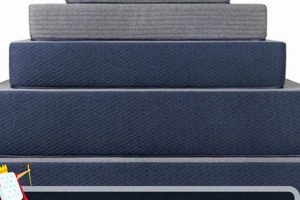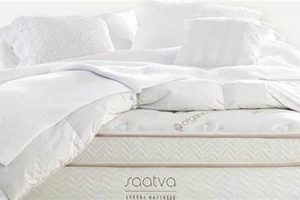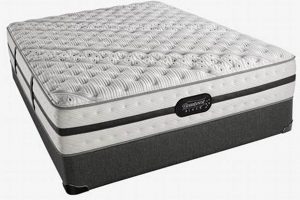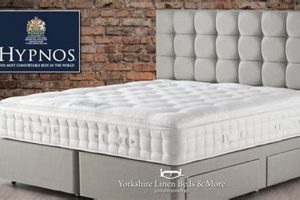The optimal sleeping surface for a young child transitioning from a crib is a critical element in ensuring restful and safe sleep. This particular product is designed to provide appropriate support, firmness, and safety features tailored to the developmental needs of toddlers. Selecting a sleeping surface for a toddler is a pivotal decision for parents.
The correct choice promotes healthy spinal alignment, reduces the risk of suffocation or entrapment, and contributes to overall well-being. Historically, the development of specific toddler sleeping surfaces has evolved in response to increased awareness of Sudden Infant Death Syndrome (SIDS) and the physical needs of growing children. This has led to improvements in materials, construction, and safety standards.
Therefore, the following discussion will focus on the key attributes to consider when evaluating available options, including material composition, safety certifications, firmness levels, size considerations, and budget-friendly alternatives, to assist parents in making informed decisions.
Essential Considerations for Selecting an Appropriate Toddler Sleeping Surface
Ensuring a safe and supportive sleep environment for a toddler is paramount. The following tips offer guidance in selecting a surface that promotes healthy development and minimizes potential risks.
Tip 1: Prioritize Firmness. A firm sleeping surface is crucial for a toddler. It reduces the risk of suffocation and provides the necessary support for proper spinal alignment during this formative developmental stage.
Tip 2: Seek Certifications. Look for certifications from independent organizations, such as CertiPUR-US or GREENGUARD Gold. These certifications verify that the product has been tested for harmful chemicals and emissions, ensuring a healthier sleep environment.
Tip 3: Consider Material Composition. Options include innerspring, foam, and hybrid constructions. Foam should be high-density to provide adequate support. Innerspring options should have a sufficient coil count to ensure durability and firmness. Hybrid models combine features of both. Natural materials like organic cotton and wool can minimize exposure to synthetic chemicals.
Tip 4: Verify Size Compatibility. Ensure the sleeping surface fits snugly within the toddler bed frame. Gaps can pose a safety hazard, potentially leading to entrapment. Standard toddler bed dimensions should be consulted to ensure a proper fit.
Tip 5: Evaluate Waterproofing and Breathability. A waterproof cover is essential for protecting the mattress from spills and accidents. Breathable materials help regulate temperature and reduce the risk of overheating, which is particularly important for toddlers.
Tip 6: Assess Edge Support. Adequate edge support prevents sagging and provides a stable surface when a child is sitting or standing near the edge of the bed. This contributes to overall safety and durability.
Tip 7: Establish a Budget. Prices can vary significantly. Determine a budget beforehand to narrow down options. Balancing cost with essential features and safety certifications is crucial.
These considerations are not exhaustive but offer a foundation for informed decision-making. The selection of a suitable sleeping surface contributes significantly to a toddler’s comfort, safety, and overall development.
Next, we will address specific product types and provide a comparative analysis to further refine the selection process.
1. Firmness
Firmness is a non-negotiable attribute of a sleeping surface intended for toddler use. The selection of a “best toddler mattress” hinges critically on this characteristic due to its direct impact on safety and musculoskeletal development. Excessive softness can create an indentation, posing a suffocation hazard for a toddler who lacks the motor skills to reposition effectively. Conversely, insufficient firmness fails to provide adequate support for the spine, potentially leading to discomfort or hindering proper postural development. Regulatory bodies and pediatricians consistently emphasize the necessity of a firm surface to mitigate these risks. The absence of appropriate firmness disqualifies a product from consideration as an optimal choice for this age group.
The direct consequences of inadequate firmness are observable in real-world scenarios. For instance, toddlers sleeping on excessively soft surfaces may experience interrupted sleep due to the lack of support, resulting in irritability and impaired cognitive function. Furthermore, prolonged use of an unsuitably soft mattress can contribute to poor posture habits. The practical significance of understanding this connection lies in the ability of caregivers to make informed purchasing decisions, prioritizing safety and long-term well-being over superficial features such as plushness or decorative elements. Reputable manufacturers routinely provide firmness ratings or specifications to guide consumer selection.
In summation, the connection between firmness and a suitable toddler sleeping surface is paramount. Prioritizing firmness, substantiated by adherence to safety standards and recommendations from healthcare professionals, is crucial for ensuring a safe and developmentally supportive sleep environment. Challenges remain in consumer awareness and the marketing of deceptively soft products. However, by understanding the inherent link between firmness and safety, caregivers can navigate the market effectively and select a product that aligns with the fundamental needs of a growing child.
2. Safety Certifications
The presence of recognized safety certifications is a pivotal factor in identifying an appropriate sleeping surface for toddlers. These certifications provide independent verification that a given product has undergone rigorous testing and meets established safety standards related to chemical emissions, flammability, and overall material safety. Prioritizing certified products mitigates potential health risks and ensures adherence to established safety guidelines.
- CertiPUR-US Certification
This certification ensures that the foam components within a mattress have been tested and found to be free of certain harmful chemicals, including phthalates, ozone depleters, and heavy metals. Mattresses bearing the CertiPUR-US label provide assurance of reduced chemical exposure for the child during sleep, minimizing potential respiratory or skin sensitivities.
- GREENGUARD Gold Certification
GREENGUARD Gold certification indicates that a mattress has been tested for low chemical emissions, contributing to healthier indoor air quality. This is particularly relevant for toddlers, who spend a significant amount of time sleeping in close proximity to the sleeping surface. It helps minimize exposure to volatile organic compounds (VOCs) that can trigger allergies
or respiratory issues. - Oeko-Tex Standard 100 Certification
This certification verifies that all components of the mattress, including fabrics and fillings, have been tested for harmful substances. It ensures that the product meets strict human-ecological requirements, limiting the presence of allergenic dyes, pesticides, and other potentially harmful chemicals that could come into contact with the child’s skin.
- Flammability Standards Compliance (16 CFR Part 1633)
Compliance with federal flammability standards is crucial for fire safety. This regulation mandates that mattresses meet specific requirements to resist ignition and slow the spread of fire, providing critical time for evacuation in the event of a fire emergency. Verification of compliance with this standard is essential for minimizing fire-related risks.
The absence of these certifications raises concerns about the potential presence of harmful chemicals or inadequate fire safety measures, diminishing the suitability of a sleeping surface for a toddler. Selecting a sleeping surface for toddlers with verified safety certifications provides parents and caregivers with a greater degree of confidence in the product’s safety and overall suitability for a young child.
3. Material Composition
Material composition is a primary determinant of a sleeping surface’s suitability for toddlers. The specific materials used directly influence factors such as safety, comfort, durability, and overall health. A “best toddler mattress” prioritizes materials known for hypoallergenic properties, breathability, and non-toxicity. For example, mattresses constructed with organic cotton or natural latex minimize exposure to synthetic chemicals that could potentially cause allergic reactions or respiratory irritation in young children. Conversely, mattresses made with conventional polyurethane foam may contain volatile organic compounds (VOCs) that can off-gas and negatively impact indoor air quality. The choice of materials, therefore, represents a critical safety consideration.
The physical characteristics of various materials also affect a sleeping surface’s performance. High-density foam, for instance, offers adequate support and prevents sagging, contributing to proper spinal alignment during sleep. Innerspring mattresses, when constructed with a sufficient coil count and durable materials, provide a firm and responsive surface. The practical significance of understanding material properties lies in the ability to assess a mattress’s long-term durability and suitability for a growing child’s changing needs. An informed choice of materials extends the lifespan of the mattress and ensures consistent support and comfort over time. Consider, as an example, the common practice of incorporating a waterproof layer made of polyurethane. Although effective at protecting the mattress core, this material is not breathable and can cause overheating in children. A more breathable option, such as a laminated cotton or wool barrier, is preferred.
In summary, the selection of materials for a toddler sleeping surface directly influences its safety, comfort, and durability. Prioritizing non-toxic, hypoallergenic, and breathable materials is crucial for creating a healthy and supportive sleep environment. While cost considerations may factor into purchasing decisions, prioritizing material composition can mitigate potential health risks and ensure long-term value. The connection between material composition and the qualities defining a “best toddler mattress” is thus inseparable. Challenges persist in consumer awareness and the accessibility of transparent material information. However, by understanding these fundamental connections, caregivers can make informed choices that promote the well-being of their children.
4. Size Compatibility
Size compatibility is a critical, non-negotiable attribute of a “best toddler mattress.” The dimensional conformity between the mattress and the toddler bed frame is fundamental to ensuring safety and preventing potential hazards. If a mattress is too small for the frame, gaps are created along the edges, posing a risk of entrapment for a toddler’s limbs or head. Conversely, if a mattress is too large, it may become compressed, affecting its intended firmness and support characteristics, and potentially damaging the bed frame itself. Therefore, the selection of a toddler mattress necessitates precise adherence to standardized size specifications.
The most prevalent standard for toddler bed mattresses in North America is approximately 28 inches wide by 52 inches long. Deviation from these dimensions can have significant consequences. For instance, a mattress that is even a half-inch narrower than the bed frame can create a sufficient gap for a child’s arm to become lodged, potentially leading to injury or distress. Similarly, an oversized mattress may cause the bed frame to bow or warp over time, compromising its structural integrity. The practical significance of understanding size compatibility is exemplified by real-world instances of product recalls related to improperly sized mattresses creating unsafe sleeping environments. Adherence to established size standards, combined with careful measurement prior to purchase, is imperative for mitigating such risks. Furthermore, verifying the mattress’s dimensions upon receipt, prior to placing it in the bed frame, is a crucial step in ensuring compatibility and safety.
In summary, size compatibility is an indispensable component of a “best toddler mattress” due to its direct impact on safety and the prevention of entrapment hazards. The practical application of this understanding necessitates adherence to standardized dimensions and careful verification prior to use. Challenges may arise from variations in manufacturing tolerances or inconsistencies in labeling; however, a meticulous approach to measurement and verification can effectively address these challenges, ensuring a secure and supportive sleep environment for the toddler. This direct link between size compatibility and safety underscores its paramount importance in the selection process.
5. Waterproof Barrier
The presence of an effective waterproof barrier is a key characteristic when evaluating the suitability of any sleeping surface intended for toddler use. This feature protects the internal components of the mattress from liquid intrusion, which is a common occurrence during this developmental stage. The integrity of the waterproof barrier directly impacts hygiene, longevity, and the prevention of potentially harmful microbial growth within the mattress core.
- Hygiene Maintenance
Toddlers are prone to accidents, spills, and bodily fluid leakage during sleep. A waterproof barrier prevents these liquids from penetrating the mattress core, where they can create unsanitary conditions and harbor bacteria or mold. This contributes to a cleaner and healthier sleep environment.
- Mattress Longevity
Moisture absorption can degrade the materials within a mattress, leading to premature breakdown and reduced support. A waterproof barrier extends the lifespan of the mattress by preventing moistur
e-related damage to foam, coils, and other internal components. - Odor Prevention
Trapped moisture can lead to unpleasant odors that are difficult to eliminate. A waterproof barrier minimizes odor buildup by preventing liquids from seeping into the mattress and creating a breeding ground for odor-causing bacteria.
- Allergen Control
A waterproof barrier can also function as a barrier against dust mites and other allergens that can accumulate within a mattress. By preventing these allergens from penetrating the core, it helps create a more hypoallergenic sleep environment, particularly beneficial for toddlers with sensitivities or allergies.
Therefore, the presence of a reliable waterproof barrier is not merely a convenience but a necessity for maintaining a hygienic and durable sleeping surface for toddlers. The feature is of utmost importance in ensuring safety and suitability. The selection of materials for waterproof barriers should also be carefully considered. While vinyl is an effective barrier, it’s not breathable and can be uncomfortable. Materials like polyurethane laminates, or tightly woven fabrics with a waterproof coating, offer better breathability, reducing the risk of overheating.
6. Edge Support
Edge support, referring to the structural reinforcement along the perimeter, plays a crucial role in defining a suitable sleeping surface for toddlers. The presence and quality of this support directly impact safety, stability, and the overall usable surface area, rendering it a critical feature to evaluate when selecting a “best toddler mattress.”
- Safety and Fall Prevention
Robust edge support minimizes the risk of a toddler rolling off the mattress, particularly during sleep. Reinforced edges provide a more stable and secure perimeter, reducing the likelihood of falls. This is especially relevant as toddlers often sleep near the edge of the bed.
- Usable Surface Area
Effective edge support maximizes the usable surface area of the mattress. A well-supported perimeter prevents sagging or compression near the edges, allowing the toddler to utilize the entire mattress surface for sleeping and playing safely. This is particularly beneficial in smaller toddler beds.
- Structural Integrity and Durability
Strong edge support contributes to the overall structural integrity of the mattress. It helps maintain the shape and firmness of the mattress over time, preventing premature wear and tear. This enhances the mattress’s long-term durability, ensuring consistent support and comfort.
- Ease of Getting In and Out of Bed
Adequate edge support facilitates easier and safer transitions in and out of bed for toddlers. A firm edge provides a stable surface for the child to sit on while getting in or out, promoting independence and reducing the risk of falls during these transitions.
The composite effect of these facets directly informs the selection process. Mattresses lacking sufficient edge support compromise safety and reduce usable space, thereby diminishing their suitability for toddler use. Therefore, diligent assessment of edge support characteristics is essential when evaluating mattress options, ensuring that the selected surface contributes to a safe, stable, and durable sleep environment for the child.
Frequently Asked Questions about Selecting a “Best Toddler Mattress”
This section addresses common inquiries and concerns regarding the selection of an appropriate sleeping surface for toddlers, emphasizing safety, support, and durability.
Question 1: What firmness level is considered optimal for a “best toddler mattress?”
A firm surface is recommended. A mattress that is too soft can pose a suffocation risk and fail to provide adequate spinal support. It is important to look for models specifically designed with this level of firmness in mind.
Question 2: Are safety certifications truly necessary when choosing a “best toddler mattress?”
Yes, certifications such as CertiPUR-US and GREENGUARD Gold indicate that the mattress has been tested for harmful chemicals and emissions. Such certifications provide an added layer of assurance regarding product safety and indoor air quality.
Question 3: What materials should be avoided in a “best toddler mattress?”
Materials containing phthalates, formaldehyde, and high levels of volatile organic compounds (VOCs) should be avoided. Opt for mattresses with natural or certified low-emission materials.
Question 4: How important is a waterproof cover for a “best toddler mattress,” and what type should one look for?
A waterproof cover is crucial for protecting the mattress from spills and accidents. Look for covers made from breathable materials like polyurethane laminate, rather than vinyl, to prevent overheating.
Question 5: What size mattress is appropriate for a toddler bed?
The standard dimensions for a toddler bed mattress are approximately 28 inches wide and 52 inches long. Accurate measurement of the bed frame is essential to ensure a snug and safe fit.
Question 6: How often should a toddler mattress be replaced?
The lifespan of a toddler mattress depends on its construction and usage. Regularly inspect the mattress for signs of wear, sagging, or damage. Replacement may be necessary every 5 to 7 years, or sooner if significant deterioration is observed.
Prioritizing safety certifications, appropriate firmness, and non-toxic materials is paramount when selecting a sleeping surface for a toddler. Careful consideration of these factors will contribute to a healthier and more secure sleep environment.
The following section will provide a comparative analysis of specific toddler mattress models currently available on the market.
Conclusion
The preceding exploration of the “best toddler mattress” underscores the multifaceted considerations critical to informed selection. Key factors, including firmness, safety certifications, material composition, size compatibility, waterproof capabilities, and edge support, represent non-negotiable elements in ensuring a safe and supportive sleep environment. Emphasis has been placed on the long-term implications of these choices for the child’s health and development.
The selection of a sleeping surface should not be approached as a trivial purchasing decision. Instead, it demands careful research, attention to detail, and a commitment to prioritizing the well-being of the child. The ongoing refinement of industry standards and advancements in material science offer the potential for even safer and more supportive sleeping solutions in the future. Parents and caregivers are encouraged to remain vigilant and proactive in their pursuit of a product that truly represents the “best toddler mattress” for their individual needs.






![Top Rated Best Feather and Down Mattress Toppers - [Year] Guide Organic & Natural Mattress Buyer’s Guide: Non-Toxic Sleep Solutions Top Rated Best Feather and Down Mattress Toppers - [Year] Guide | Organic & Natural Mattress Buyer’s Guide: Non-Toxic Sleep Solutions](https://mattressworldpa.com/wp-content/uploads/2025/07/th-7652-300x200.jpg)
